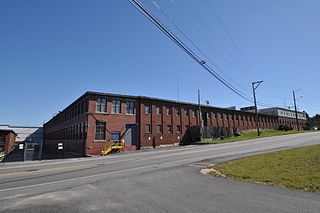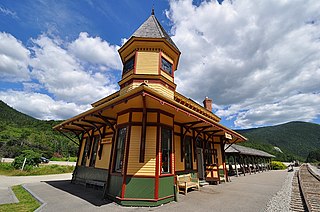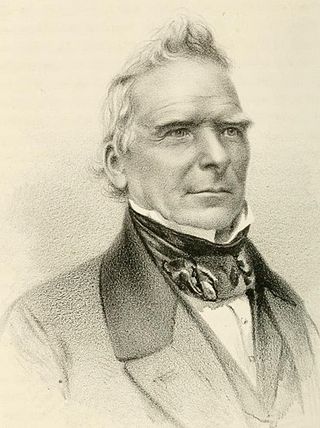Related Research Articles

Windham is a town in Cumberland County, Maine, United States. The population was 18,434 at the 2020 census. It includes the villages of South Windham and North Windham. It is part of the Portland–South Portland–Biddeford, Maine Metropolitan Statistical Area.
The Central Vermont Railway was a railroad that operated in the U.S. states of Connecticut, Massachusetts, New Hampshire, New York, and Vermont, as well as the Canadian province of Quebec.

The Maine Central Railroad was a U. S. class 1 railroad in central and southern Maine. It was chartered in 1856 and began operations in 1862. By 1884, Maine Central was the longest railroad in New England. Maine Central had expanded to 1,358 miles (2,185 km) when the United States Railroad Administration assumed control in 1917. The main line extended from South Portland, Maine, east to the Canada–United States border with New Brunswick, and a Mountain Division extended west from Portland to St. Johnsbury, Vermont, and north into Quebec. The main line was double track from South Portland to Royal Junction, where it split into a "lower road" through Brunswick and Augusta and a "back road" through Lewiston, which converged at Waterville into single track to Bangor and points east. Branch lines served the industrial center of Rumford, a resort hotel on Moosehead Lake and coastal communities from Bath to Eastport.

Crawford Notch is a major pass through the White Mountains of New Hampshire, located in Hart's Location. Roughly half of that town is contained in Crawford Notch State Park. The high point of the notch, at approximately 1,900 feet (580 m) above sea level, is at the southern end of the town of Carroll, near the Crawford Depot train station and Saco Lake, the source of the Saco River, which flows southward through the steep-sided notch. North of the high point of the notch, Crawford Brook flows more gently northwest to the Ammonoosuc River, a tributary of the Connecticut River.

The Bridgton and Saco River Railroad (B&SR) was a 2 ft narrow gauge railroad that operated in the vicinity of Bridgton and Harrison, Maine. It connected with the Portland and Ogdensburg Railroad from Portland, Maine, to St. Johnsbury, Vermont, near the town of Hiram on the Saco River.

The Portland & Ogdensburg Railroad was a railroad planned to connect Portland, Maine to Ogdensburg, New York. The plan failed, and in 1880 the Vermont section was reorganized and leased by the Boston & Lowell Railroad. In 1886, the Maine and New Hampshire section was reorganized as the Portland & Ogdensburg Railway. That part was leased to the Maine Central Railroad in 1888, and in 1912 the Maine Central leased the eastern part of the Vermont section from the Boston & Maine Railroad, the successor to the B&L.

Horace Fairbanks was an American politician and the 36th governor of Vermont from 1876 to 1878.

The Presumpscot River is a 25.8-mile-long (41.5 km) river located in Cumberland County, Maine, United States. It is the main outlet of Sebago Lake. The river provided an early transportation corridor with reliable water power for industrial development of the city of Westbrook and the village of South Windham.

The S. D. Warren Paper Mill is a paper mill on the Presumpscot River in Westbrook, Maine. It is now owned by SAPPI Limited, a South African paper concern. It is one of Westbrook's major employers. The mill complex and former worker and management housing associated with the mill's operation in the 19th century were listed on the National Register of Historic Places in 1974 as the Cumberland Mills Historic District.

Samuel Page Benson was a United States representative from Maine. He was born to Peleg and Sally Benson in Winthrop, Massachusetts on November 28, 1804. He received instruction from private teachers and attended the Monmouth Academy of Maine. He graduated from Bowdoin College in 1825. He studied law, was admitted to the bar and commenced practice in Unity. He returned to Winthrop and practiced law until 1850.

The Cumberland and Oxford Canal was opened in 1832 to connect the largest lakes of southern Maine with the seaport of Portland, Maine. The canal followed the Presumpscot River from Sebago Lake through the towns of Standish, Windham, Gorham, and Westbrook. The Canal diverged from the river at Westbrook to reach the navigable Fore River estuary and Portland Harbor. The canal required 27 locks to reach Sebago Lake at an elevation of 267 feet (81 m) above sea level. One additional lock was constructed in the Songo River to provide 5 feet (1.5 m) of additional elevation to reach Long Lake from Sebago Lake. Total navigable distance was approximately 38 miles (61 km) from Portland to Harrison at the north end of Long Lake. A proposed extension from Harrison to Bear Pond and Tom Pond in Waterford would have required three more locks on the Bear River, but they were never built.
The St. Johnsbury and Lamoille County Railroad (StJ&LC) was a railroad located in northern Vermont. It provided service to rural parts of the state for over a century, until track deterioration and flood damage made the line unusable and uneconomical to repair, which forced the line to close in 1995. Vermont is in the process of converting the roughly 96-mile route from St. Johnsbury to Swanton into a rail trail, known as the Lamoille Valley Rail Trail. Once completed it will be the longest rail trail in New England.

South Windham is a census-designated place (CDP) in the town of Windham in Cumberland County, Maine, United States. The population of the CDP was 1,374 at the 2010 census. Prior to 2010, South Windham was part of the Little Falls-South Windham census-designated place.

Crawford Depot, also known as Maine Central Passenger Railway Station, is a historic passenger railroad station at the top of Crawford Notch in the Bretton Woods area of the town of Carroll, New Hampshire. Built in 1891, it is a surviving emblem of the importance of the railroad in the area's history as a tourist destination, and is one of the finest examples of Queen Anne railroad architecture in northern New England. Now home to a visitors center operated by the Appalachian Mountain Club, it was listed on the National Register of Historic Places in 1982. It is also the northern terminus of most trains on the "Notch Train" service of the Conway Scenic Railroad.

Gorham is a town in Cumberland County, Maine, United States. The population was 18,336 at the 2020 United States Census. In addition to its urban village center known as Gorham Village or simply "the Village," the town encompasses a number of smaller, unincorporated villages and hamlets with distinct historical identities, including South Gorham, West Gorham, Little Falls, White Rock, and North Gorham. Gorham is home to one of the three campuses of the University of Southern Maine. In 2013, Gorham was voted second-best town in Maine after Hampden by a financial website.

William Pitt Preble was an American lawyer, judge, diplomat and businessman. He was one of the first Justices of the Maine Supreme Court and U.S. Minister to the Netherlands.
The Sebasticook and Moosehead Railroad was a 19th-century Maine railroad which became the 20th century Harmony Branch of the Maine Central Railroad.

Union Station was a train station in the Libbytown neighborhood of Portland, Maine, which operated from 1888 to 1960. Located on St. John Street, it was demolished in 1961 and is now the site of a strip mall.

The Bartlett Roundhouse, also known as the Bartlett Engine House, is a historic railroad service facility in Bartlett, New Hampshire. Located just south of United States Route 302 and east of Pine Street, it consists of a multibay service building and the remains of a 56-foot (17 m) railroad turntable which provide access to the service bays. Built in 1887–88, it is a reminder of the historic importance of the railroad in the local economy. The site was listed on the National Register of Historic Places in 2015, and the New Hampshire State Register of Historic Places in 2008.
The Morrisville Depot located at 10 Depot Street in Morrisville, Vermont, is a decommissioned historic train station. Built in 1872 to serve the Portland and Ogdensburg Railway, the depot was known as the most important train station for the Vermont lumber industry, for its decorative architectural ornament, and for housing the headquarters of the St. Johnsbury and Lamoille County Railroad from 1959 to the early 1970s. It was subsequently converted into a restaurant. The Morrisville Depot was added to the National Register of Historic Places in 1982 as building #15 in the Morrisville Historic District.
References
- ↑ "Legislators' Biographical Database". legislature.maine.gov.
- ↑ "Samuel J. Anderson, Portland, ca. 1890". Maine Memory Network. Maine Historical Society.
- ↑ "History: Building Frankenstein Trestle". Conway Scenic Railroad.